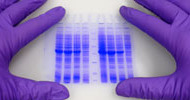
 Categories
Categories  Protein Expression
Protein Expression


The inauguration of monoclonal antibodies (mAbs), derived from mice, were immunogenic in humans. These molecules were first synthesized in 1975 by Georges...

Nanoparticles (NPs) undergo interactions with serum proteins during systemic administration, which may result in the formation of protein corona (PC)....

Due to their large surface area-to-volume ratio, nanoparticles (NPs) rapidly adsorb proteins on their surface upon contact with biological fluids, forming a...

Humans are highly organized systems comprised of approximately 3.72x1013 cells of various types, which maintain proper organ function and normal cellular...

With the rapid development of biotechnology, drug research and development has gradually entered a new era of precision and personalization. Targeted Protein...

Structural biology has always played a vital role in drug discovery because it provides the most direct and visible atomic-level information on drug targets...

In X-ray diffraction (XRD) experiments, X-rays bombard macromolecules, and the scattered X-rays are analyzed to provide detailed three-dimensional (3D)...

Microcrystal electron diffraction (MicroED) is a novel technique that uses cryo-transmission electron microscopy (Cryo-TEM) for the three-dimensional (3D)...

Cryo-electron tomography (cryo-ET) is an imaging technique used for high-resolution three-dimensional (3D) reconstructions of biomolecules, primarily for...

The Cryo-EM Single Particle Analysis technique involves preparing numerous molecular samples with identical structures. These are dispersed and vitrified for...

All cellular protein functions, including those involved in disease processes, require coordinated movements at the atomic or domain level, known as...

Many drugs target proteins that function as receptors for small-molecule ligands. These ligands bind to and alter the structures of their protein targets,...

Monoclonal antibodies (mAbs) are powerful therapeutic tools. These glycoproteins, belonging to the immunoglobulin (Ig) family, are utilized by the immune...

PROTACs represent a novel strategy for protein degradation that has gained prominence recently. Utilizing bifunctional molecules, PROTACs enable the targeted...

PROTACs represent a novel strategy for protein degradation that has gained prominence recently. Utilizing bifunctional molecules, PROTACs enable the targeted...

Residual DNA (rDNA) refers to the aggregate of deoxyribonucleic acid (DNA) and fragments extracted from recombinant host cells, commonly termed as residual...

Biopharmaceuticals, drugs produced by living cells, have revolutionized the treatment of various diseases since Eli Lilly and Company's introduction of the...

Antibodies (Abs) are essential components of the adaptive immune system, which can combat infections and other harmful agents. Produced by B cells, Ab is...

Nanoparticles (NPs), owing to their unique physical, chemical, and biological properties such as controllable size, tunable surface properties, and excellent...

Due to significant developments in mass spectrometry (MS) technology and software, quantitative proteomic analysis has become the primary method for protein...